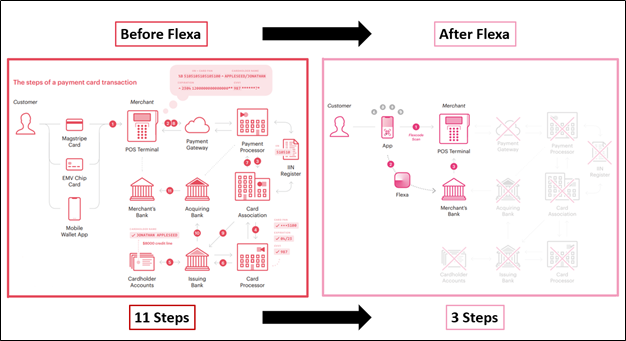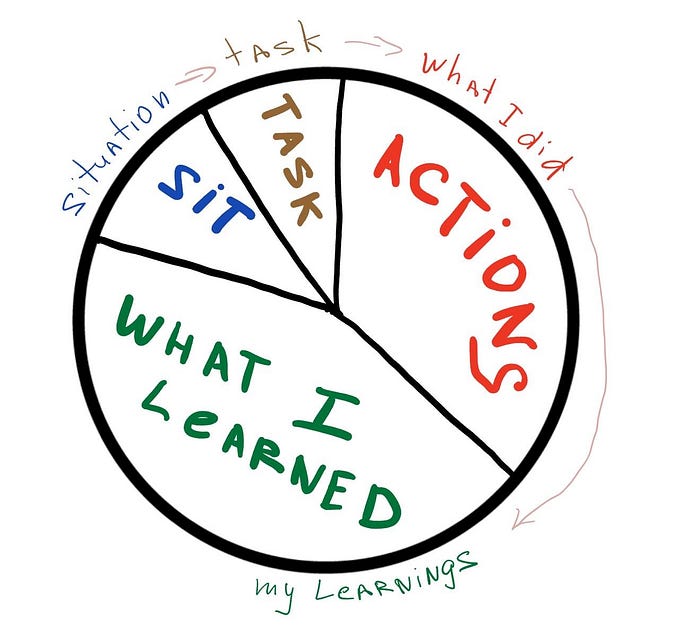Flexa: Eliminating the Middleman in e-Payments
Introduction
Dis-intermediating the electronic-payments system was the first use case envisioned for cryptocurrencies. The first sentence of the Bitcoin whitepaper, titled “Bitcoin: A Peer-to-Peer Electronic Cash System,” reads: “Commerce on the Internet has come to rely almost exclusively on financial institutions serving as trusted third parties to process electronic payments.” Bitcoin has since pivoted towards a store-of-value narrative. However, using blockchain to eliminate payment middlemen remains a market opportunity.
Flexa is an open-source application seeking to capitalize on this opportunity. Flexa offers a Software Development Kit (SDK) built on Ethereum, in partnership with ConsenSys, to facilitate both in-store and online payments. The following shows the high-level concept:

The basic idea is to drive “mainstream usability” of crypto at traditional retail stores and e-commerce sites, said Flexa co-founder Tyler Spalding on the Funky Crypto Podcast. Flexa’s vision is to become a payments industry standard used by software developers worldwide. Developers can embed crypto-spending features into applications to benefit users. With Flexa built into an app, users can spend crypto assets instantly, without paying any conversion fees. Merchants accepting crypto through Flexa get fraud protection at no cost and receive near-instant settlement in fiat.
Merchants pay much lower transaction fees than what they currently pay to centralized payment systems, such as Visa and Mastercard. Lowering fees not only benefits merchants but also makes the system more efficient by eliminating middlemen, potentially lowering prices for consumers, and improving a system that favors large over small businesses, since big companies have greater capacity to absorb costly transaction fees. Visa and Mastercard charges — known as swipe fees — are one of the biggest pain points for merchants, costing 2–3% of each transaction, according to Pymnts.com. Thus, Flexa is solving a real-world problem using blockchain.
How Flexa Works
Instead of running on top of existing payment infrastructure built by Visa, Mastercard, and other financial institutions, Flexa has developed its own decentralized, fully compliant, crypto-payment rails. Flexa is a blockchain application that has native integrations with existing point-of-sale terminals used by merchants. Thus, merchants do not need to acquire new devices to accept payments through Flexa.
The following shows how Flexa disintermediates the payments system:

Here is how the process works in detail. First, a user must have crypto in a Flexa-enabled digital wallet app on a mobile device. The user pays for goods and services using the crypto asset of their choice while the merchant receives payment in fiat. The app generates a barcode, called a “flexcode,” that gets scanned by the cashier to authorize and guarantee a transaction.
Behind the scenes, Flexa is converting the user’s digital asset into fiat and using Flexa’s native token, called Amp, as collateral. Flexa pays a crypto-to-fiat conversion fee of approximately 0.10% while charging the merchant about 1% for the transaction, so Flexa ends up with 0.90 percent. Amp token holders collateralizing the Flexa-enabled wallet app earn the entire 0.90% through automatic distribution.
Anyone can buy the Amp token and provide collateral to ensure that the crypto-to-fiat transaction goes through to the merchant. The consumer and cashier have no idea that Amp exists. But it’s the Amp token that bridges the crypto-to-fiat transaction, enabling near-instant processing times at the point of sale, according to Spalding. By reducing the number of payment steps from 11 to three, Flexa can charge merchants much lower fees. Flexa also provides merchants with faster settlement.
The Amp Token
Amp is an Ethereum ERC-20 token. The utility of Amp is to provide crowd-sourced collateral for e-payments, securing transactions awaiting confirmation on Ethereum. Amp ensures a transaction will settle, and thus Flexa can advance fiat to a merchant in real time to complete a sale. In return for collateral, Amp token holders receive pro-rata yield, based on their staked Amp, from payment fees on every successful transaction.
The transparent, tamper-proof, and verifiable features of blockchain are useful for detecting and preventing fraud. The decentralized Ethereum blockchain, along with payment collateralization through Amp, make traditional types of payment fraud impossible, according to Spalding, writing for Cryptopedia. However, if a payment does not confirm (e.g., there is some malicious activity or blockchain vulnerabilities), staked Amp is removed from the collateral pool and sold for fiat, so the merchant still gets paid in fiat.
Staking Amp offers a yield of 3.9% Annual Percentage Yield (APY), as of this writing. The yield varies depending on the volume of spending flowing through the network. Amp has a Sharpe Ratio (i.e., returns per unit of risk) of 2.62 compared to 2.30 and 1.80 for Ether and Bitcoin, respectively, over the last 12 months, based on Messari data. Thus, Amp has performed better than Ether and Bitcoin on a risk-adjusted basis over the last 12 months.
Amp has a fixed, maximum supply of 100 billion tokens and a circulating supply of 42 billion, according to Messari. The following graph shows a breakdown of Amp token allocation:

The long-term success of the Amp token depends on real-world adoption of the Flexa network by users, developers, and merchants. The price appreciation of the token depends directly upon its real-world utility. Amp is backed by its use in traditional commerce. Amp’s fixed supply and staking returns, wherein Amp is deposited as collateral in return for fee income, contribute to the long-term value capture of the token.
The Amp token was initially called Flexacoin (FXC). In September 2020, the token was upgraded to provide faster, near-instant transactions and re-branded as Amp (AMP). Collateral operations are now performed entirely on-chain in a single transaction, improving the security of the collateralized transaction system, according to Flexa. Flexacoin holders were required to migrate their old Flexacoin tokens to the new Amp token.
Seeking Product-Market Fit
Flexa is seeking to not only solve problems for merchants by lowering fees, but also to enable crypto users to spend stablecoins and other digital assets for everyday purchases. Supported stablecoins include USD Coin, Gemini Dollar, DAI, and Celo Dollar, according to Flexa’s website. The Flexa system, including software integrations with mobile payment apps, eliminates the consumer-experience friction of using crypto for retail purchases.
The following shows the strategic elements helping Flexa to win users, developers, and merchants:

Flexa’s focus on regulatory compliance is a key factor enabling real-world adoption. Reputable retailers have adopted the technology through Flexa’s integrations with NCR, Woo Commerce, and Shopify (“coming soon”). Using Flexa, shoppers can spend their coins at Nordstrom, Crate & Barrel, Whole Foods, Office Depot, and Bed Bath & Beyond, among other major retailers, according to Fast Company.
Flexa-enabled mobile payment apps include Gemini and Flexa’s own app called Spedn. Non-custodial mobile payment apps, including Dharma and Breadwallet (BRD), are coming soon, as early as this summer. The Amp token and related code are open sourced under the MIT license.
The strategy is a business-to-business (B2B) solution through integrating Flexa technology into third-party mobile apps. Flexa has raised $14.1 million in start-up capital over three rounds. Investors include Pantera Capital and 1kx, according to Crunchbase. Furthermore, Flexa has the support of Gemini and the Winklevoss twins; Crypto stored via the Spedn mobile app is custodied through Gemini. Flexa is listed for trading on Coinbase, Gemini, and decentralized exchanges, such as Uniswap, Balancer, and Bancor. Based in New York City, the team behind Flexa includes experienced entrepreneur Tyler Spalding, who successfully founded and exited from Tastebud Technologies, a predictive analytics solution for retailers.
Risk Considerations
Flexa faces an uphill battle against entrenched, deep-pocketed incumbents, such as Visa, on the merchant-facing back end and fintech apps, such as PayPal, on the consumer-facing front end. These competitors have established themselves in the market and have network effects that can be difficult to compete against. In March of this year, Visa announced a pilot program for settling transactions directly in USD Coin on Ethereum through partnerships with Crypto.com and crypto-custody solution Anchorage.
PayPal made a similar announcement in March of this year, stating that customers could make retail payments using crypto held in their PayPal wallet for “select online purchases.” PayPal’s new service, called Checkout with Crypto, allows customers the option to quickly convert crypto holdings into dollars at checkout for no additional fee. Eligible purchases offer fraud protection, free return shipping, and purchase protection.
Conclusion
Flexa is delivering on the original use case mentioned by Satoshi Nakamoto in the Bitcoin whitepaper: peer-to-peer electronic payments. With the upcoming addition of support for non-custodial wallet apps, such as Dharma and Breadwallet, Flexa is well positioned to differentiate itself and compete against big payment intermediaries, including Visa and PayPal.
Unlike these centralized custodial providers, the open-source Flexa SDK will soon offer self-custody and truly decentralized payment capabilities through user-friendly, third-party mobile apps. Flexa is eliminating centralized financial intermediaries through innovative application of blockchain technology, which translates into lower fees for merchants, potentially lower prices for consumers, and a way to improve the existing e-payment system that favors large over small businesses.
Disclosures and Disclaimers: I own positions in ETH and AMP. This blog post is for educational purposes only and is not intended to be financial or investment advice. Please do your own research.
For more, join me on Twitter.










